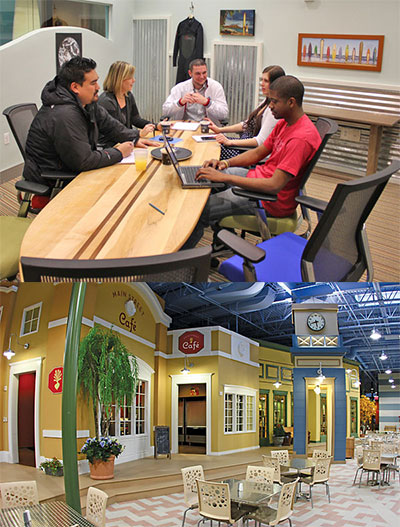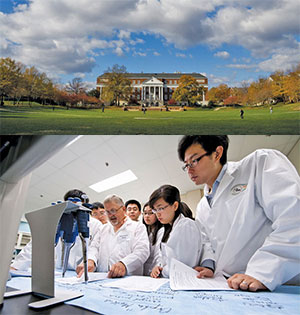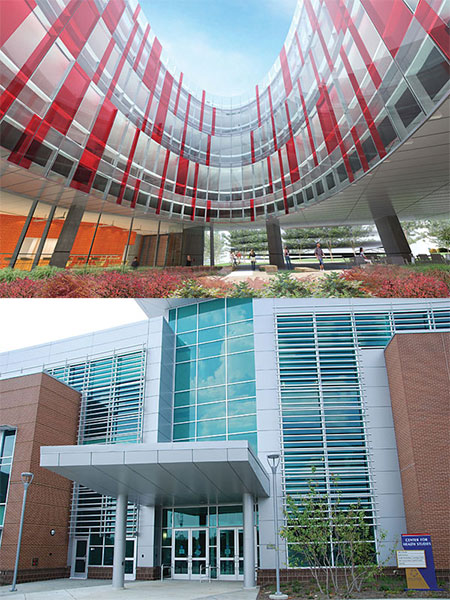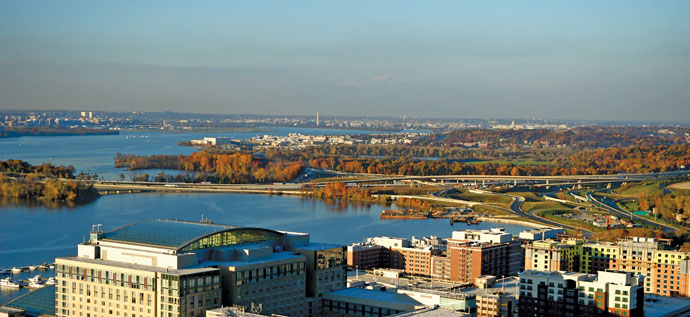With a work force ranked among the nation’s best, the No. 1 public school system in the U.S., world-class academic and research institutions and a competitive business environment, Maryland is an ideal place for companies to grow and thrive. In Prince George’s County, those advantages are only accentuated, as businesses benefit from proximity to Washington, D.C. (without the cost); the University of Maryland College Park (the University System of Maryland’s flagship institution) and federal agencies representing nearly every department of the U.S. government; and burgeoning industry clusters such as aerospace, space, cybersecurity, healthcare and life sciences.
Toss in a decided trend toward transit-oriented, live-work-play development; proactive new policies in transportation and education; a forthcoming casino resort approved by voters in 2012; a strong bid for the new FBI headquarters; and an unparalleled $50-million incentive fund, and you have a recipe for economic development success.
Creative Hub
Drop by the Vocus headquarters in Beltsville for a taste of the county’s future.
Led by University of Maryland alumnus Rick Rudman, president and CEO, Vocus uses propriety software to help organizations manage relationships with the media, distribute online news releases, and monitor and analyze news and social media. After 13 years in a pricier locale, company leaders started looking around for a new home, driven partly by costs and partly by their vision.

“Best. Workplace. Ever.” That’s what Vocus aspires to at its 90,000-sq.-ft. headquarters in Beltsville, which features a surf-themed conference room, arcade, gym, spa and café.
Photos courtesy of Vocus
“Rent in Bethesda for traditional high-rise office space is $35 to $40 per square foot,” says Steve Vintz, executive vice president and CFO at Vocus. “It’s less than half that here.”
But even more important, he says, was the drive to “create a great facility for our employees.”
What they found might not immediately strike you as a dreamscape: a one-story, 100,000-sq.-ft. warehouse. Inside, they’ve created Vocus Town, complete with gym, spa, café, fanciful meeting spaces and catered meals.
“Last year we added 450 new employees, and ended the year with about 1,200,” says Vintz, citing an average salary between $55,000 and $80,000. “This year we’re going to hire hundreds more, so we’re growing pretty aggressively.”
The location makes sense for Vocus, as it draws talent from Virginia, Maryland and D.C., with 25 percent of the work force residing in Prince George’s County. “Baltimore is 35 minutes away, and Virginia is up I-495,” he says. “You get some traffic, but people make the commute.”
Vintz says his team looked at Virginia, D.C. and elsewhere before making the move to Beltsville about a year and a half ago, but chose to move just up the road from its former home in Lanham in order to avoid employee churn, the corporate tax structure in Virginia and the higher costs of D.C.
“The county executive, county and state stepped up and provided a nice package of incentives for us to be here,” he says, amounting to about $1.5 million in property tax abatements and credits, training grants and “loans that convert to grants if you meet hiring thresholds, which we’ve easily exceeded.”
Vintz says the company is also scaling up at its facility in Manila, Philippines, and notes that parking in Beltsville has become the company’s biggest challenge. But he says the county government and Prince George’s County Economic Development Corp. have “done a lot to keep us happy … I know Prince George’s County wants to attract more technology employers.”
Focus on Technology
Indeed it does, agrees Brian Darmody, assistant vice president for research and economic development at University of Maryland College Park (UMCP), the state university system’s flagship campus located in the county.
“This year we’re going to hire hundreds more, so we’re growing pretty aggressively.“
— Steve Vintz, CFO, Vocus
“Overall, the university is a big economic engine with a $1.7-billion annual budget, and we’re one of the largest employers in the county,” says Brian Darmody. “We do about half a billion dollars of research a year.”
But fostering more work just outside the walls is what’s top of mind now.
“We were recently awarded one of the five national hubs for I-Corps, the innovation corps that the NSF [National Science Foundation] has created,” says Darmody, with work on the project just starting up in April. “The idea is to more effectively train federal as well as university researchers to create teams to create companies. Our hope is with the I-Corps we’ll create more companies and have them proximate to the university. A lot of knowledge transfer happens through informal means, and having companies near the university helps.”
“We love Maryland and we like the technology community here,” says Naly Yang, director of marketing for electric-vehicle charging station manufacturer and developer SemaConnect. The company got its start in founder Mahi Reddy’s basement in Anne Arundel County to the north, and moved to Prince George’s in 2012 in order to find better manufacturing space for the 25-person operation. The firm’s products are commercial grade, and the area is ripe for installations at both business parks and the growing roster of mixed-use developments. Yang says the company has yet to form a research partnership with area colleges, but the talent is there and ready whenever positions come open.
“It’s an exciting thing,” she says, “because there aren’t that many companies like us here on the East Coast. Whenever there are opportunities, we’re just flooded with resumes. Most opportunities in the area are government-related, so something like SemaConnect is like a breath of fresh air.”
Vintz at Vocus says that sentiment rings true for his company too.
“Absolutely,” he says of his work force demographic, which is starting to skew just below 30 years old. The company operates a database research facility on the UMCP campus, and draws from a number of area colleges. “Obviously government is a big industry here, and the last couple years have been great for that industry. But in the past year or so, govcon [government contracting] has slowed down. The kind of people we hire — just out of school or with a few years of experience — they want to work for a tech companies.”
They also, he says, seem to be picking the area they want to live first, and then finding a job that’s close by. Hence the Vocus focus on parking and the commute. Prince George’s County boasts 15 Metro stations, as well as a bus system, but the bus from the New Carrolton station currently stops half a mile from Vocus. Vintz is working with the county on possible options for both commuter parking and a shuttle bus that the company would operate.
As the CFO, one of Vintz’s metrics is cost-per-hire. The special amenities of the Vocus campus-in-a-warehouse may have cost a bit more to construct, but “we want to create a true destination for the state’s tech talent.” Apparently it’s working: Inbound resumes have more than doubled since the move to Beltsville, and the rate of new hires from employee referrals has almost doubled too, to 20 percent.
‘Unprecedented’
Prince George’s County Economic Development Corp. serves as the chief point of contact for existing county businesses and those considering operations in the county. It’s not averse to doing business with those companies itself: Strativia, an IT and software development company, has been a resident of the EDC’s Technology Assistance Center (TAC) incubator for three years, and recently designed the EDC’s new logo and website.
Powered by Knowledge
The University of Maryland College Park and its 37,000 students continue to catalyze innovation in Prince George’s County.
The federal government in October 2012 opened the Center for Weather and Climate Prediction of the National Oceanic and Atmospheric Administration (NOAA) at M Square, the University of Maryland Research Park. The new center brings together more than 800 NOAA employees from several different outdated buildings and puts them in an innovative, state-of-the-art facility.
M Square is a public-private partnership between Corporate Office Properties Trust and UMD. When fully built out, it will encompass 2 million sq. ft. and employ an estimated 6,500 people. Key technology clusters at the park include: environmental and earth sciences (NOAA Center for Weather and Climate Prediction, Joint Global Change Research Institute, and Earth System Science Interdisciplinary Center); food safety and agriculture policy (USDA Animal and Plant Health Inspection Service, UMD/FDA Joint Institute for Food Safety and Applied Nutrition, and FDA Center for Food Safety and Applied Nutrition); and language and national security (Center for Advanced Study of Language, National Foreign Language Center, Raytheon, and Intelligence Advanced Research Projects Activity).
 Photos by John T. Consoli/University of Maryland
Photos by John T. Consoli/University of MarylandBrian Darmody, assistant vice president for research and economic development at University of Maryland College Park (UMCP) sees the need for more second-stage incubators to satisfy demand. But in the meantime, the Maryland International Incubator is one of several serving to connect companies, ideas and whole countries, with the latest effort involving the U.S.-Russia Foundation. And such institutions as the food safety complex (above) draw people from near and far.
“Delegations come from around the world to be trained in food safety programs for their countries,” he says. “We’re training the trainers here at the university.”
Gwen McCall, president and CEO of Prince George’s Economic Development Corp., sees a number of factors coming together to foster the type of lifestyle and working environment that such young, tech-savvy talent craves, beginning with new state transportation funding that will not only improve commutes, but contribute indirectly to the even more transit-oriented, mixed-use development in the area.
“That will be a huge plus for us going forward,” she says, noting such developments as National Harbor from The Peterson Companies, the coming Konterra Town Center development, the strong possibility of a major casino resort from MGM, and the county’s equally strong bid for the new FBI headquarters (the GSA is mulling candidates this spring).
But financial amenities can enhance the landscape as much as the structural kind. A major tool available to companies looking at locating in the county is its $50-million Economic Development Incentive fund. Since its Nov. 2011 inception under the dynamic administration of County Executive Rushern Baker, the fund has made loans worth a total of $2.4 million to six different companies, and has leveraged a combined $26.8 in private investments so far. The EDI Fund has been credited with saving 480 jobs and creating 510 new jobs in the county, and its resources have helped projects ranging from Vocus to small firm Man and Mouse (a maker of germ-free keyboards) to a Hampton Inn to a new expansion in Landover from food distributor Nash Finch.
By comparison, a similar fund in Montgomery County has $1 million. McCall calls the seven-year EDI program “unprecedented,” while noting that it’s subject to annual evaluation by the county council, and also only available on a “but for” basis. But even with those qualifiers, “that is a significant amount of money to assist companies that may have an interest in growing in the county,” she says. She cites an unnamed firm in the aerospace sector.
“They had grown beyond their capacity, and were considering whether to collocate with their parent company out West or move to another county,” she says. “But with the fund, plus matching funds from the Maryland Department of Business and Economic Development, we were able to get that company to remain here.

New institutional infrastructure in Prince George’s County includes the forthcoming $128-million Physical Sciences Complex at University of Maryland College Park (top) and the Center for Health Studies at Prince George’s Community College.
Images courtesy of HDR and PGCC
“Just having that funding helps us remain competitive,” she continues. “Site selectors shopping other areas would say, ‘What do you have to offer to assist with a move or expansion?’ Until the EDI fund, we couldn’t offer that. It allows us to be at the table, and part of the whole process.”
“We have come out of the gate strong, but we want to do better by speeding up the process so that companies can begin expanding their businesses sooner,” said County Executive Baker in January. “The more companies apply, the more investments we can make. The more investments we make, the more our county’s commercial tax base grows and we increase revenues to improve our schools, health, and safety.”
McCall sees County Executive Baker’s work to further improve public education in the county making tremendous strides. She also just welcomed a notable area leader as chairman of the board at Prince George’s County EDC: Wayne Curry, the former county executive and current president of NAI Michael who, among other accomplishments, helped attract the Washington Redskins to FedEx Field in the county.
“President McCall and Mr. Baker’s economic development team have really taken the bull by the horns and re-energized our efforts to attract and retain local businesses,” Curry said upon his appointment. “I want to use my position to supplement their efforts and to become a stronger advocate for all the opportunities that lie before us.”
Out in Front
The opportunities are strong indeed. A Greenbelt location for a new FBI headquarters has received backing from the Maryland delegation on the Hill and is a front-runner.
“They’re looking for a consolidated high-tech campus for 11,000 employees,” explains David Iannucci, the former Maryland secretary of economic development who now serves as the county’s assistant deputy chief administrative officer for economic development and public infrastructure. “Criteria include being close to metro stations. Our location is next to the Greenbelt station, proximate to the University of Maryland, close to the National Security Administration and not far from Joint Base Andrews. We’re putting a major emphasis on it.”
Prince George’s County is home to NOAA, NASA Goddard Space Flight Center, Joint Base Andrews (home of Air Force One), the University of Maryland at College Park, Bowie State University, Prince George’s Community College, Howard University Beltsville, Woodmore Town Center, Steeplechase International Business Park, Washington Redskins FedEx Field and Six Flags America.
One major driver may be this fact: More than 25 percent of the federal work force in the National Capital Region resides in Prince George’s County, but currently less than 5 percent of the region’s federal office space is located in the county.
At National Harbor, a 350-acre development on the Potomac River, The Peterson Companies see the $800-million casino proposal from MGM Resorts as a front-runner too, after Maryland voters passed a casino gambling measure in Nov. 2012. National Harbor already has plenty in its favor, including the Gaylord National Resort and Convention Center. A decision from the state on the casino location is expected by the end of 2013.
Meanwhile, the transit-oriented development boom continues.
“The consensus is we have more opportunities for high-quality transit-oriented mixed use development than any jurisdiction in the area,” says Iannucci. Though the county has lagged its neighbors in such projects, it is attuning many of its policies, priorities and incentives to put greater focus on generating development by its 15 Metro stations, he says. “We’ll work with national developers of quality, and put extraordinary incentives on the table.”
Other projects of note include a new regional medical center in the county, and the pending location of the Maryland Dept. of Housing and Community Development, which would mark the first time a major state agency would call the county home.
In addition to the in-town mixed-use opportunities, Gwen McCall says the county’s nearly 500 sq. miles include much land that still remains undeveloped, and available at an affordable price. Who knows? Some of that land might one day be occupied by companies born much farther away than Annapolis. In November 2011, McCall and a delegation of elected officials and business leaders joined in a state trade mission to India. The result was $60 million in business opportunities coming to Maryland — $20 million to Prince George’s County.
Whether a company is migrating from costly neighbor territories, a university campus or a foreign territory, it will find a soft landing in Prince George’s County, thanks to business-friendly policies, procedures, people and, most of all, vision.
This Investment Profile was prepared under the auspices of Prince George’s County Economic Development Corp. For more information, visit www.pgcedc.com or call 301-583-4650.
